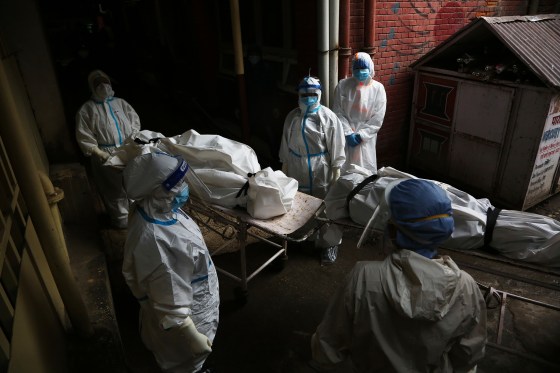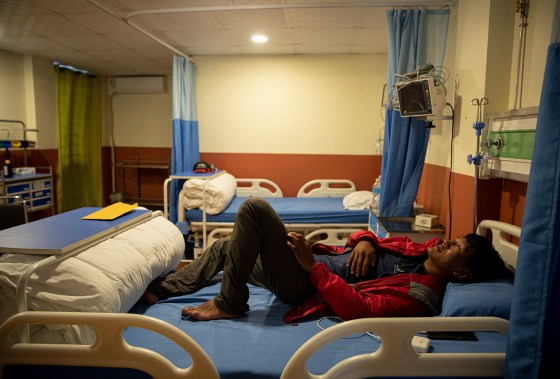Everest South Base Camp lies at an altitude of 17,598 feet (5,364 m), but it is no refuge from the global pandemic. The Nepali Sherpas who, in normal times, share the camaraderie of climbers on the world’s highest mountain, now enforce strict social-distancing rules, remaining within their separate camps—indeed, mostly inside their own tents.
“We have made a rule not to walk from one camp to another as some climbers have tested positive,” says Phunuru, a Sherpa guide. “If we see somebody new walking around our camp, we immediately start an inquiry.”
Officially, there is no coronavirus here. “Around 100 people have scaled Everest last week and rest will be climbing this week,” Rudra Singh Tamang, director general of the Department of Tourism, tells TIME. “Everything is fine.”
But many climbers say otherwise. “The COVID situation at [Base Camp] is a total s—storm,” American Gina Marie Han-Lee wrote in a Facebook post in late April. “I had no clue what I was flying into.” Other climbers, from Norway and the U.K., have tested positive and one local doctor—who declined to be named, citing official harassment—told TIME that “two dozen climbers have been evacuated from Base Camp to Kathmandu and they later tested positive at a hospital.”
What happens on this remote, majestic mountain poses questions for tourism operators everywhere. Countries are making tentative attempts at reopening, but If the pristine environment at the roof of the world can’t be kept free of COVID, what chance is there for the beaches of Cancun, the bustling city squares of Europe, or the shopping malls of Asia, once travelers flock back to them? For poorer nations—and struggling communities like the Sherpas—that are heavily dependent on tourism, the developments at Everest are a bleak warning.

Nepal’s COVID-19 Crisis
To be sure, the news from Base Camp is the least of Nepal’s worries right now. With the two countries sharing a porous, 1,100 mile (1,770 kilometer) land border, it was inevitable that the devastating wave of COVID afflicting India should spread to its northern neighbor and overwhelm the feeble health care system. On May 20, Nepali authorities reported 8,227 new cases and 190 deaths, with the country’s total case tally approaching 488,700. The rate of 29 COVID cases per 100,000 people in the last week has overtaken India’s 21.
“We are running out of oxygen and hospital beds, we have a huge lack of health workers,” says Dr. Samir Adhikari of the Ministry of Health and Population. “Nepal cannot handle this situation anymore.”
Even before the pandemic, it struggled to provide health care to its people. The latest available World Bank figures show that the country has less than one doctor per 1,000 people and only one hospital bed for every 3,000. Only 26 of the country’s 185 hospitals had oxygen plants, local media reported at the end of April, and of those not all were in working order. The situation is especially dire in remote areas, where isolated populations have very limited access to basic health care due to high cost and low availability.
Given the tragic lack of resources, people are now dying on the streets, in ambulances, at hospital gates, or at home after failing to find treatment, and the disease is spreading virtually unchecked. Daily confirmed cases increased by over ten-fold from mid-April to mid-May, when more than 45% of tests conducted produced positive results. As with India, the holding of political rallies and religious festivals in recent months may have exacerbated the situation. Many Nepalis also believe the virus was spread by Indian workers transiting in Nepal en route to jobs in the Gulf states, when those states banned direct flights from India.
For some exhausted front line health workers, the battle is already lost. “We are helpless,” says a despairing Dr. Subhah Panta, emergency medical officer at the Tribhuvan University Teaching Hospital. “People have two choices—go home or go to cremation.”
At the hospital, a grieving Yadav Upreti tells TIME that his 50-year-old brother Radha Krishna Upreti died when his cylinder ran out of oxygen. “Radha Krishna was the only income source for the family, and I don’t know who will take care of his two small kids and wife now,” Upreti says. “It’s actually murder by the government, as it’s not able to give us basic treatment.”
Many Nepalis accuse the authorities of failing to take the threat of a major outbreak seriously enough. The government has been riven by factional strife and Prime Minister K.P. Sharma Oli lost a vote of confidence on May 10. Besides being preoccupied with political survival, he also reportedly placed too much store in what he saw as the country’s natural defenses against COVID. According to local media, the prime minister believed coronavirus would not make much headway in Nepal because of the “strong” immune systems of Nepali people and the country’s “rich Ayurvedic traditions.” He has since walked back his position and was quoted on May 17 as saying “But now, (I realized) a normal immune system could not resist this.”
With a rudimentary health system and an ill-prepared government, it’s unsurprising that no part of the country has been spared, whatever the elevation. In the humid, far western lowlands of the country, with a tropical and subtropical climate, Kailali forms as great a contrast as can be had to the mountainous, snow-covered Nepal of the popular imagination. At the district’s Tikapur Hospital, 26 COVID patients died in a week due to a lack of oxygen. There are no available beds.
“I have been giving phone treatment to more than 50 patients,” sighs Dr. Ramesh Prasad Upadhyay. “That’s what I can do for now.”
Vaccination is not an immediate solution. Only 7% of Nepal’s 30 million people have been jabbed. Two million doses were ordered from India’s Serum Institute, the world’s largest producer of vaccines. But because of the crisis in India, New Delhi ordered a halt to vaccine exports, leaving Nepal a million doses short.
As coronavirus tears through an unprotected population, the cremation teams work overtime. TIME counted 12 cremations during a brief, 30-minute visit to the Pashupati cremation center in Kathmandu. One of them was of Mohat Singh’s mother. “We can’t cremate her according to the proper rites,” he says, distraught, watching from a distance as Nepali troops carried out the grim task. “Two of my brothers are in isolation. COVID has destroyed our family.”
At the Sukraraj Tropical and Infectious Disease hospital in Kathmandu, Dr. Sher Bahadur Pun, chief of the clinical research unit, says “Ninety-nine percent of people are dying from COVID because they did not get treatment.”
Outside, 39-year-old Shanta Bhattarai says she has been waiting four days for admission. “It’s been five days since I tested positive,“ she tells TIME. “I have a fever and can’t breathe. Will I survive?”

Tourism, Sherpas and the Pandemic
The disastrous outbreak has meanwhile put any thought of economic recovery on hold. With eight of the ten highest mountains in the world, Nepal has long been an irresistible destination for serious mountaineers, rock climbers, and trekkers. Tourism is the largest industry, employing 800,000 people, and is the country’s main source of foreign exchange. In 2019, Nepal welcomed 2 million visitors, who parted with $724 million.
Small wonder that the government began making strenuous attempts to reopen to adventurers at the end of last year, approving a record number of 408 Everest expeditions for 2021. Many climbers traveled to the country believing that Nepal’s first wave, in the second half of 2020, represented the peak of infections, and reasoned that they would be avoiding the riskier cities. Erlend Ness, a Norwegian climber who became the first person to test positive at Everest, wrote on Facebook that “the fact that I was going up in the mountain short time after arriving Kathmandu felt safe.” He wasn’t alone. This season, Base Camp has been crowded with some 1,300 climbers, Sherpas and support staff.
For visitors and locals alike, Everest is the jewel in the crown. With mountaineers needing to pay $11,000 each for a climbing permit—to say nothing of the revenue generated by accommodating, transporting, guiding and feeding international expeditions—the lofty peak is Nepal’s single most lucrative attraction. Fees alone have generated nearly $4.2 million this year, according to information posted to Twitter by Mira Acharya, the director of the mountaineering division at the Department of Tourism.
Much of that wouldn’t be possible without the Sherpas (the name derives from the words Shyar, or “East,” and Pa, or “People,” in their language). The ethnically Tibetan group numbers some 150,000 and is famed for producing elite mountaineers who have made immeasurable contributions to Himalayan exploration. But, even at the best of times, they struggle.
“Basically, I earn $6,000 to $8,000 a year, which is just enough to live on” says one, Daring Sherpa, who has a family to support and like many of his community uses Sherpa as a last name. “If I don’t work this year, I won’t even be able to pay for food.”
By “work,” he means mountaineering. There are hardly any other jobs in the uplands. Food costs five times what it does in Kathmandu because of the remoteness of the area and health facilities are scant. A sick Sherpa either has to walk into town or spend as much as $3,000—potentially half a year’s income—for a helicopter evacuation to the capital.
“Sixty percent of Sherpas are working as guides because we don’t have other job options and because we are not formally educated,” Panaru Sherpa tells TIME. “Not all Sherpas are happy with climbing Everest,” he adds as one who has summited 12 times. “We are doing it for a living.”
With the coronavirus now rampaging through Nepal, many are having sleepless nights as expeditions think about pulling the plug. Austrian expedition operator Furtenbach Adventures did so on May 15. To climb “with these massively increasing [COVID] numbers,” said its principal Lukas Furtenbach, “would be irresponsible.”
Dadoma Sherpa’s 56-year-old husband, Dorje Sherpa, is still at work on the mountain—but “I haven’t been able to sleep after I heard that COVID reached Base Camp,” she tells TIME. “I’m trying to call my husband, but his phone isn’t reachable. One half of my heart says call him back home, and the other half says ‘If I call him back home, what are we going to eat?’ We have two kids studying. We will not be able to pay for their education if he comes home.”
At Gorakshep, a collection of basic lodges that is the last stop on the trek up to Base Camp, hotel owner Pasang Sherpa understands the desperation. “If Sherpas don’t get work this year, they may die from hunger,” he says. Given the importance of Sherpas to the business of mountaineering, and the crucial role Himalayan expeditions play in Nepal’s economy, the ripple effects will be felt far beyond the snow-capped peaks.
Perhaps this is the reason for the air of grim determination hanging over Base Camp, where a 19-year-old Sherpa guide has become one of the latest climbers to be stricken with a cough and a fever.
“Even if it is COVID, I can’t go back home,” she says, asking not to be named. “I have to finish my mission.”

0 Comments